I have to show you the photos from my latest noma lunch, because René did it again! The menu I got on April 30 completely overwhelmed me. This is why I’ll never be tired of dining at noma; the variations at all times and the urge to serve and please every new or often frequenting diner in the very best way. I got a whole new set menu of incredible dishes plus three classic ones, because it was my friend diner’s first visit to noma. Look and enjoy. Please.
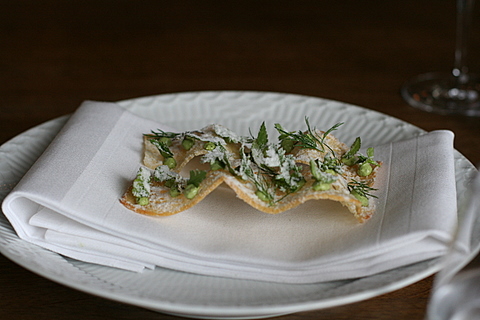
Bread crunch with herb cream, herb emulsion and vinegar dust
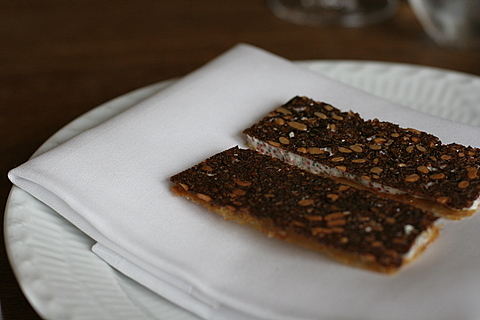
Lumpfish roes with cream and pressed by
rye bread and chicken skin
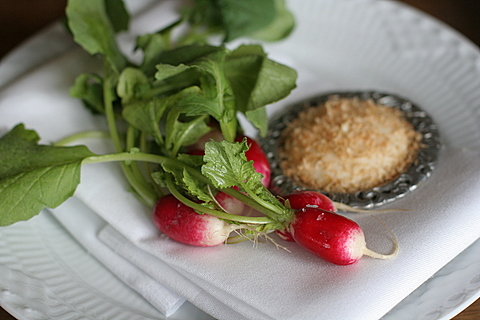
Organic radishes with a cream comprising turbot roes
and topped with grated dried turbot roes
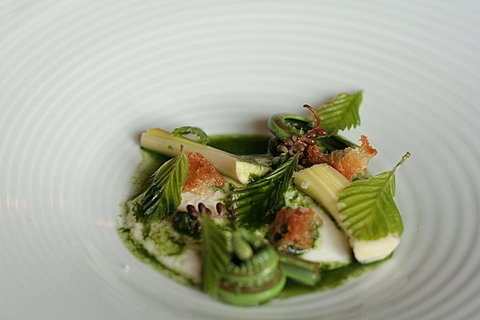
Fresh cow’s milk cheese with birch shoots, celery (I believe), fresh leaves and sauce of grass and birch bark
This creation was very refined a delicate but at the same time it offered a rich milk taste that was balanced with the herbs’ and the leaves’ acidity and a bit of salt from the croutons. An excellent and new take-off.
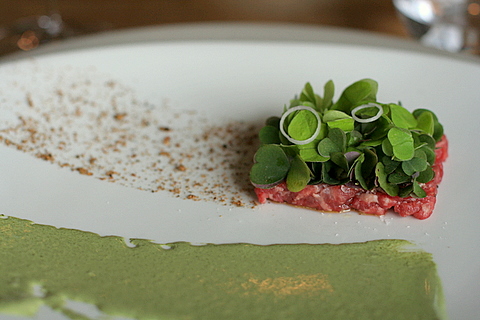
The famous signature dish of the ox tartar
I’ve had this dish a few times now but this serving was incredibly good, better than previous visits. I think it’s related to the fact that the herbs were at their first and the fact that the meat seemed a little more fatty.
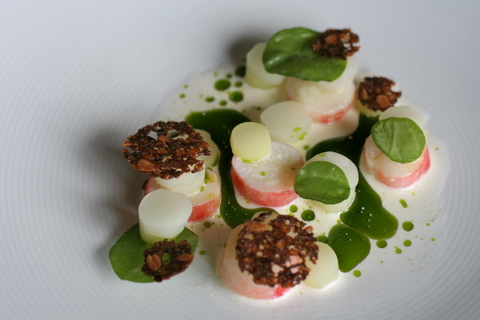
7-year-old king crab from Norway, leeks, crispy rye bread, garden sorrel
Superb creation and even better than the king crab leeks rolled in ashes I got in October last year. By the way, how do they know how old the crab is anyway?
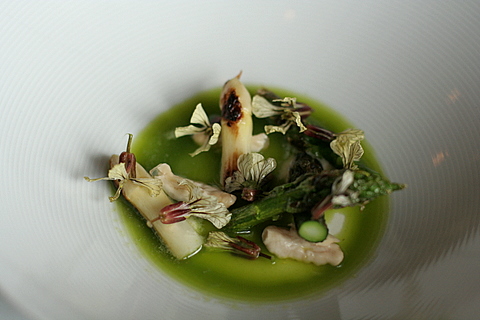
The year’s first lovely green and white asparagus grilled and with smoked marrow, beautiful rucola flowers, juice of asparagus and chick weed.
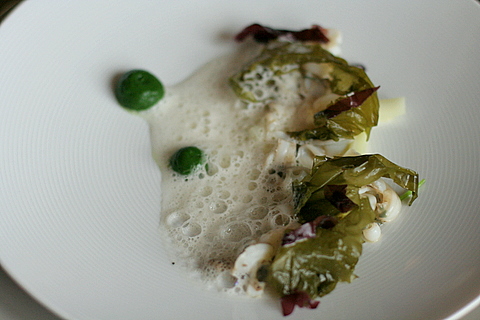
Razor clams, celeriac, cauliflower stems, two types of Icelandic seaweed, parsley puree, razor clam and oyster sauce.
Imagine you are walking along the beach a chilly day of spring. Think of the salt nip in the air and the smell of seaweed. Sense the first warm sunbeam sweetly on your cheek. This is what the dish was like. Heavenly clear and pure with remarkable distinction. The sense of the sea.
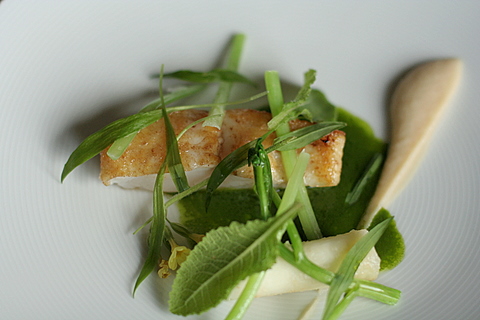
Turbot, ramson leaves and stems, celeriac cooked in hay, cowslip and watercress emulsion
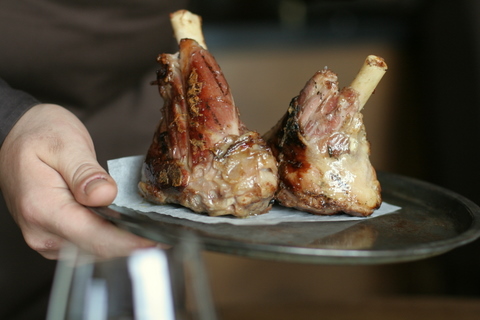
The lamb shank for the main course was presented to us before plating. The lamb was cooked at 64 C for 24 hours.
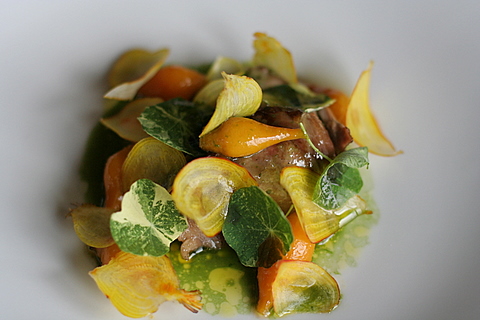
Lamb shank, Indian cress, yellow beets two ways, herb sauce
First time I have lamb there. This was a beautiful and delicious dish, but it seemed to miss out something, which I think could a bit of sour or acidity in some way.
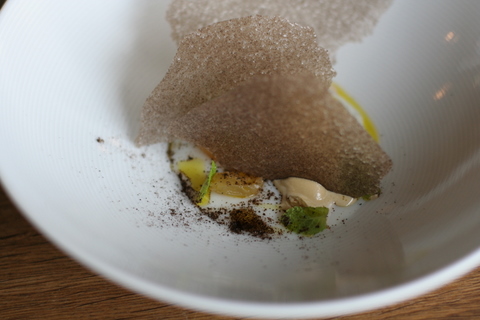
The Classic: Buttermilk gel, reduced sugar beet juice,
raisins in akvavit, tuile of sugar beets
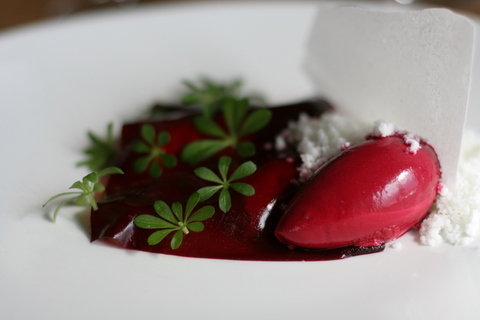
Gel of beet and rhubarb underneath,
beet sorbet, yogurt snow and green woodruff
This is what marks out noma from any restaurant experience I have had in my life. Utmost innovation and perfection. Look at these beautiful green flowery leaves and notice how precisely the stems have been removed to complete the image. Not too much and not too less.
It’s difficult for me to put my experience of this into words because it became an emotional experience of enjoying the sweet/sour balanced dessert. I was impressed by the excellency of this whole new the dish.
According to the website, Noma’s intention is to create and to prepare a distinctly advanced kind of cuisine, while nonetheless conjoining the patently Nordic approach with a manner of purity and simplicity in the approach. Congratulations – you have reached your goal! I can’t wait to experience what will follow.
Thank you.

Don’t be so tough on yourself, JC! 🙂
Almost 5 months after the fact (I took the summer off – undskyld!), I finally finished my report:
http://upescalator.wordpress.com/2008/09/27/noma-hunter-gatherer-haute/
Wow, I really suck at this blogging thing. 😉
Hi Thomas 😀
Congrats on your new cool EOS-450D camera! And kind thanks for the flowers.
To answer your question first, the pics in this post were all taken with the same Canon 50 mm Prime f/1.4 IS USM lens. My noma posts from 2007 were all taken with either the kit lens (18-55 mm) or the Canon Ixus 950is.
You know what? I think I’ll write a camera page to make that the place for all these foodphotonerd comments so they are easy to find!
Happy summer greetings to you too!
Trine
Hi Trine,
Just reading these comments now.
First – once again a great report from Noma’s best costumer.
Your pictures are as always unbelievable (also kudos to the Camera wizard backstage, Klaus) and I have been reading the Camera tips with great interest. I have had my SLR Camera for 2 month now (Canon EOS-450D) and have now realized that I have been doing everything wrong ;-).
My concept in life is “Never go down on the equipment” – so for sure I will have to invest in a utterly expensive lense of some sort – maybe this Canon EF-S 17-55mm f/2.8 IS USM, which looks crispier than the Noma Snacks.
Happy summer greetings from,
/Thomas
PS. Just a quick question – pictures of the restaurant, persons, ambience etc. are they also taken with your little Canon EF 50mm f/1.4 lense?
I hate that “customer pays credit card fee” thing. In California, we have a law that forbids merchants from adding a surcharge whenever a customer chooses to pay with a credit card. The rationale is that a merchant would have fewer customers if he did not accept credit cards. Many other U.S. states have such a law.
That said, noma, while still very expensive, was a bit cheaper than I thought it would be. I could spend more eating at some of the top restaurants here in L.A., with no currency exchange to make things more expensive. Though that might include a little more wine. 😉
Dear Neil
Apologies! Your comment got caught by by spam filter for an unknown reason.
Lovery with the tip on Kitchen’s – thank you so much.
And THANK YOU, for this comment and your question about the tipping:
Are there any readers working in Copenhagen’s best restaurants that might shed some light on tipping practices and expectations in the city?
I am in the same boat with your wife. Usually I don’t tip, but I also feel a little bad about not doing it.
You’re right about the extras for foreign credit cards! DK IS a mini put state. do you know whether all the fine dining restaurants in CPH charge the extra?
Fantastic photos – I will continue reading!
JC, Henrik wasn’t present at the restaurant that evening as he was preparing the opening of their Asian Bistro (The Ricemarket). Nevertheless a restaurant with a Michelin star should have people capable of presenting both the food and the wine.
The food was good though, I’m just puzzled by the fact that a restaurant with such (inconsistent) service can get a Michelin star.
Klaus, thanks! You’re not alone in your camera-geekdom. 😉
Trine, I would have to agree, especially given noma’s reputation for sourcing ingredients from the wild. Wild animals are supposed to taste better than farmed animals, right?
Allan, I’m sad to hear you had a bad experience at Kiin Kiin. I failed to take any wine notes, but I don’t remember experiencing any such mistakes. Chef Henrik served and presented nearly all of our dishes – the soup is the only one I distinctly remember as being served by someone else. Were the mistakes you experienced made by him, or by one of his staff?
Thanks for the update on the lamb. I’ve always found these cooking methods interesting, hence I was wondering how it ended up.
I’m way behind with updating my blog – and I should write about Ristorante Cracco in Milano and Kiin Kiin. Hopefully I’ll do it soon, but I wasn’t impressed by Kiin Kiin, e.g. twice we weren’t told what we were eating and one of the times it was flat out wrong when we had it corrected. Even our dessert wine was presented as “…and then a sweet dessert wine”. No information about which one – and what’s worse, it wasn’t sweet.
Anyway I’ll get to it (some day)!
I just finished a little something on Milano, but not the restaurant yet, so it might not be interesting for you 🙂 However please feel free to take a look 🙂
http://allancantona.blogspot.com/
Dennis: I’m very pleased to hear that and of course you’re more than welcome just to enjoy the read. This is the main purpose of this blog anyway. 😀
JC: I choose to think the best of the brave noma guys and believe that this seven year old crab is caught in the wild! It bet they taste better too and these were certainly tasty. What do you think? 🙂
Allan: Thank you! Long time not much seen 😉 Ehm, the lamb was thoroughly done and so moist and tender that it almost fell apart. You know how the meat is when it’s close to the bone. The taste was meaty with only hints of lamb by with a gamy-ness to it as well. I don’t recall what they said about this preparation, but when you cook at low temperature and for a long time it’s usually to obtain moisture tenderness, as far as I know.
Btw, how did you like Kiin Kiin?
Laurent: Of course! But then it will have to wait until my noma quarantine is over…eh? :o)
JC, nice tips!
Lovely lovely lovely!
I understand that the lamb dish was missing something, but how was the lamb itself when it was prepared that way? What arguments did they have for this preparation?
Great pictures 🙂
Oh, I forgot to add to #1: if necessary to obtain a non-blurry image, underexpose your shots a little by using a slightly faster shutter speed. But not too much, or your photos will look “flat” once you raise the levels in Photoshop or whatever post-processing software you use.
Trine: I think king crabs are mostly caught in the wild. If not, they should be, since they’ve become a destructive pest in the waters around Norway, which is not their native habitat…
Dennis: if I may add to the camera/lens discussion, Klaus is right on. Get what your friends get, so you can borrow lenses from one another. However, Nikon’s lens collection is overdue for an update; expect to see new lenses next month. That said, I’m a Nikon user (including compacts, though I think Canon’s might be better – Nikon doesn’t seem to care about that market segment). But the important thing is to make sure whichever brand you buy, you can get the lens(es) that fit your needs. In my opinion, the “perfect” lens for shooting food as a diner, if you don’t have a high-end “full-frame” DSLR (a DSLR whose chip is the same size as 35mm film), would be something like 30mm fixed, with an aperture of f/1.2 or 1.4, have Image Stabilization (or Vibration Reduction (VR) in Nikon terminology), and it would also be able to focus from a distance as close as 20cm. Unfortunately, such a lens does not exist as far as I know (at least, not on the Nikon side). If it did exist, it would most likely be both expensive and big. 50mm f/1.4 is a great choice otherwise. I just jumped into the SLR world myself – my friend sold me his D70s at a ridiculously good price after letting me take it on holiday, and he threw in a free 50mm f/1.8D lens because he wanted to replace it with the 50mm f/1.4, and because he already gave away the kit lens. Still, I plan to get the f/1.4 myself someday, after I get a general-purpose zoom lens.
If you still decide not to jump into the DSLR world, f/2.8 will probably be the fastest lens you’ll find. Compact cameras, for any given focal length and aperture setting, have about four times as much depth of field as an SLR lens. That makes it easier to be in focus where you want to be in focus, but when shooting things larger than a plate of food, you won’t always be able to get that lovely gradual blur. Compact cameras also allow you to focus from shorter distances than most SLR lenses, which is the one way they can be superior (along with portability of course). Nikon compacts are especially good for super-close-ups, being able to focus as close as 7.6cm or so (though traditionally they’ve been bad in other ways, like being slow to focus in low light).
A few tips for shooting in challenging restaurant conditions, regardless of camera type:
1) If there is little light, set your camera to Shutter Priority or Manual Exposure. It is more-or-less a given that in low light, your camera would automatically open the aperture to its widest, or close to it if the dining room isn’t too dark (if you would rather just use the widest aperture all the time, ensure it by using Manual Exposure). From there, fine-tune the shutter speed to get the exposure you want. But be aware that, the wider the aperture, the less depth of field you will get, and other aspects of the shot (contrast, sharpness, etc.) will suffer a bit at the widest settings.
2) If that isn’t good enough, learn to control your camera’s flash. Dial down the flash power, and learn what White Balance setting to use in order to minimize the harsh blueness of the flash’s bulb. Or, use an external flash and aim it toward the ceiling. But you can get pretty good results even with the built-in flash, especially in a DSLR. Smaller compact cameras may not allow you to adjust the flash power and White Balance enough. But use flash only as a last resort – open up the aperture, turn on IS/VR if the lens has it, and increase the ISO first.
3) Learn techniques to minimize camera shake. Breathe normally, and press the shutter release on the exhale. Support your arms against a wall, table, chair, or your own body. And especially if you are using a compact camera, hold the camera with your right hand only, then hold your right wrist with your left hand. That is actually steadier than having both hands on the camera. It’s easier to be steady with SLRs because they’re heavier.
4) If the shutter speed is getting a bit too slow to keep the camera steady, shoot in Continuous (burst) mode. Pressing the shutter release causes the camera to move; if you shoot multiple shots with one press, the shots after the first or second will have less shake, and therefore be less blurry. I usually take 3-5 shots at a time this way.
5) If you can, shoot in RAW (not JPEG) mode. RAW allows you to make adjustments to the White Balance, exposure, etc., on your computer after the fact, which can fix color and exposure problems easier than adjusting Levels/Hue/Color Balance/Curves/etc. in Photoshop can.
6) The tip I always forget: be patient. 😉 I just want to shoot and get to the eating, so I always forget to be absolutely sure about where I’m focusing, that I can turn up the ISO, etc., and I wind up with inferior shots.
And make sure you have time to get used to your new camera, before you use it at an important meal. Good luck!
When i told i wanted to go there !! :o)… but it has to be for a dinner then… and maybe noma for lunch ? :o)))
What a wonderful world…
Thank you, Klaus! 😀
And Dennis, good luck!
Laurent!? I know where we are going next time you are back in CPH. Have you checked the whites’ section of Nouveau’s wine list? I’m especially thinking the Languedoc-Rossillon part. 😉
Hi Trine
Today’s UK Observer newspaper carries a great Edinburgh review from a critic that I trust very much so you could do worse than to give ‘Kitchin’ a visit : http://lifeandhealth.guardian.co.uk/experts/jayrayner/story/0,,2281746,00.html
On the subject of eating on one’s travels, I’ve been following your advice to overseas visitors to Copenhagen with interest and a couple of issues crossed my mind. Firstly, the vexed issue of tipping and, secondly, Copenhagen’s (almost unique) habit of charging extra if customers pay with foreign credit cards.
Tipping is always an emotive subject but even after living in Copenhagen for 10 years I still am not really sure how to behave. Actually, my Danish wife finds it a struggle to come up with any hard and fast rule! For sure, there is no tipping culture here. An American visitor leaving a 20% tip will surely make serving staff extremely happy. And Michelin actually state in The Guide that tipping is unecessary but customers might like to leave a little extra.
But, Copenhagen restaurants most certainly present the credit card bill for signature with the option to add a tip. So what do they expect? On a bill of, say, 3300kr I tend to round it up to 3500. In percentage terms that is nothing – so the question is, is it insulting? The thing is, in a restaurant at this price level, a lot of staff are involved and service is normally excellent so my tiny tip is not really going to make a financial difference to anybody.
Are there any readers working in Copenhagen’s best restaurants that might shed some light on tipping practices and expectations in the city?
Foreign visitors might be shocked to find that their bill is inflated by 5% or so when they pay with credit cards. I suppose that it could be argued that it is simply being transparent with customers about real costs. But at first glance, it can appear to be extremely unfriendly to visitors and I’m not aware of the practice in other cities in the world. The thing to remember is that there really never has been a culture of credit cards in Denmark like there is in the USA or UK. So when foreign visitors started turning up with their cards, suddenly the restauranteurs took an unexpected hit to their margins.
I’d be interested in the thoughts of any visitors to way they are treated in this respect.
Neil
Hi Dennis
No prob 🙂
Canon/Nikon – it’s mostly a religious matter, I think. If your friends are into Nikon, so should you be. It makes it much easier to get good advice … and to borrow lenses, of course 🙂
Trine, it’s good to be back. I am frequently reading your blog but only rarely have time to actually comment – unfortunately. But enjoy the others postings.
Klaus… Wow, that almost not a blog post, but a PhD in macro photography 😉 Thank you very much for the write up. I can see that I still have a lot to learn in terms of photography. Your reply goes very much hand in hand with a saying of a good friend of mine, “when you buy a digital SLR camera you will soon notice that the camera is mearly an accessory to your lenses”. I was laughing at the time he said so, but I think I do begin to understand what he meant.
Most of my friends are Nikon freaks, but I guess that both Canon and Nikon are equal competitors and that it’s a matter of religion or existing lenses that makes it fall out to one over the other.
Again, thanks a lot for the detailed and professional reply. I will reconsider my compact camera buying strategy again.
Kind regards,
Dennis
Hi Dennis
As Trine’s unofficial photo advisor, I’d love to explain how the photos are made. Forgive me for getting a bit geeky here, but – as I try to tell Trine – an understanding of a few basic photo principles is necessary to get good shots.
Trine uses a Canon 350D. It’s a consumer end digital SLR, but a great, rugged camera that’s not too big to carry around. The new version, the 450D, would be the one to go for at the moment. The more “pro” Canon 40D is a very nice camera but a bit bigger and thus heavier to lug around.
She also has a small Canon IXUS 900is for emergency use – but it’s no good under low light. It simply hasn’t got the lens or the chip for it.
But even when talking about SLRs, the camera itself is really not the issue. It’s the lens that does the trick and that’s why SLRs are the ones to go for: You can change the lens.
Too avoid using flash (and you don’t want to use flash when shooting food) you must have a lens that lets as much light trough as possible – that is: It most have a wide aperture .
The lens’ F-number denotes the relationship between the lens’ focal length and the aperture (the width of the pupil, so to speak). The lower F-number, the bigger the opening (in relation to the focal length) and the more light gets through your lens. You want as much light as possible, as you want to expose your film (i.e. your chip) in the shortest amount of time possible – to avoid shaken images.
To control these settings, Trine runs the camera in “P”-mode. That means that the camera controls the aperture and the shutter time, but that she can set the ISO herself and turn off the Flash. Personally I prefer the “A”-mode, so I can control both aperture and ISO while the camera controls shutter time. Full auto mode (on Canon cameras the auto symbol is a green square) is a no go, as the flash will pop up all the time and instantly ruin your photos, not to mention your relationship with the waiters and the other guests.
The kit-lens (an EF-S 18-55 mm zoom) that comes with the 350D and 450D is an ok lens in good lighting conditions, but not a great one when shooting at low light. It’s got a max aperture at 18mm of f/3.5 (and that’s too wide an angle for food photos). There is an IS version of this lens that will probably do better under low light – I haven’t tried it, though.
So Trine uses a Canon EF 50 mm f/1.4 lens instead of the kit lens, to get as much light into the camera as possible. It’s a fixed lens (that is, no zoom).
When using an aperture as wide as f/1.4 the depth of field (DOF) becomes very shallow. That’s why it’s only possible to focus on a bit of the dish, and that makes the photo look “macro”-like. Fortunately a shallow DOF has been made quite popular by professional food photographers during the nineties, so what is basically a shortcoming of optic laws is now considered a nice touch 🙂
The EF 50mm is not a macro lens – in fact that’s a bit of a problem as you’ll need about 45cm or more of distance between you and the dish when shooting with the 50mm at f/1.4. That is sometimes hard too achieve at a restaurant as you’ll have to get up from your chair or lean back. Be careful not to fall 🙂
The best photos on this blog are shot at lunch time when light is good. Even when using a f/1.4 lens, the light at restaurants at night can be tricky. So it’s often necessary to step up the sensitivity of the camera’s chip to ISO 800 or ISO 1600. Even on a camera like the 350D, which is quite good at avoiding too much pixel noise, images shot at ISO 1600 will show some noise. Besides, the colours may often be too warm due to artificial lighting.
Too improve on the most problematic images they are run through Photoshop. Noise may be removed with the plugin Noise Ninja that can eliminate some of the pixel noise. Contrast and colours are adjusted with levels and sometimes a cooling “photophilter” or some manipulation of the Red, Green and Blue channels is needed.
Be careful, though, when removing noise with plugins like Noise Ninja – the crispy details may disappear too. Sometimes this may be counteracted by applying a sharpen filter, but the general rule is: The more you fiddle around with the image in Photoshop, the more quality you loose.
I guess that a great photo solution for food photography would be a fast, high-end zoom lens fitted with an Image Stabilizer (like this one). The IS will allow using a narrower and thus sharper aperture and shooting at shutter times well below the magic 50th of a second without any signs of shaking. But such lenses are typically more bulky than the 50mm and it’ll probably cost’ya the mean buck 🙂
Yin, as I actually have lots of plans for coming months in Berlin, The Netherlands, Belgium, France, Edinburgh (recommendations?), Paris and CPH of course, I think I can manage without noma for four months, at least 😉 The thing is, I have had many recurrent dishes which describing doesn’t add much news to this site.
Lord Rodney and JC – Hehe. 😀 I guess they would know the age of the crab from the breeding – no?
Hi Dennis,
Great to see you back here and your question about photography is not at all off topic! 🙂
It’s the lens, really that makes my pictures. I think I’ll let the expert reply to provide the best technical explanation here as it actually wasn’t me who bought it. I hope this is OK. 😉
Cheers
Trine
Hi Trine,
The pictures are amazing as usual. I think I may have asked before or seen you write about it. But what kind of camera do you use and what is your trick on capturing such great macro shots of food indoor?
My “old” Canon G6 has some problems doing great indoor shots, so I’m seriously considering getting a new one – but a bit in a limbo on what to choose. Would love an SLR camera but usually when my tasting group(s) go out, it’s a bit annoying to carry if we hit the town later in the evening. So my conclusion so far is to get a compact camera that does great macro shots.
Sorry to drag it a bit off topic – but good food shots still has to do with “Very Good Food” when sharing with others 🙂
Cheers,
Dennis
King crabs are like trees – didn’t you notice the rings? 😉
Seriously though, I tried to look it up, and it seems there is no surefire way to determine a king crab’s age, just an approximation based on size and whether or not it is mature (able to reproduce). So, that means noma committed blatant false advertising! Demand a free meal as compensation! 😉
You’re living well, Trine!! 🙂 Another great post. the King Crab dish simply looks magic! I guess they know the age from the size of the crab?(before they chop it up!!)
😀 😀 – um, I can *always* keep a secret but I can’t help you if you publish your comments on Denmark’s premier food blog! 😉
But on a semi-serious note, as a diner, I agree that more distance between each visit allows for even sharper appreciation on each renewed visit and more reflection after. Also gives more chance for the seasons to change and allows the kitchen more breathing space for greater creativity, so a good thing all around?
but of course we have to wait longer for your reports – hmmm … what will we do??!? ;p
Hi Nancy
Thank you 🙂 And happy congrats on your anniversaries!
I’m so glad you are writing again, because I got some advice from my friend Yin about hotels. Skt Petri is very nice, but they have a nightclub in the bar area at night so it can get quite noisy. Bertrams Guldsmeden which is a gorgeous mini-chain of boutique hotels. There’s a new one, Axel, that should be enjoyable. Also Adina apartments has good reports.
When I make the reservation myself, René usually prepares a special menu
mostly comprising what they plan for the coming weeks but also current dishes. Sometimes I’m used as the guinea pig – I love that of course. 😉
I would advice you to take the naassaq because it comprises both what’s current and also some of the classics like the tartar for example. If you have specific dishes that you would like to try you can easily write them noma@noma.dk and request what you’d like.
Patrice – thanks so much for your comment! You must be my first Canadian visitor. 😀 I hope you have a great time with enjoyable end memorable food. Let me know of course, if you need help with information or anything.
Ah, Walter, great to see you still read my noma posts. 🙂 And thanks for your kind greeting via Laurent!
Heh, speaking of whom, that was a real marathon! With your Paul experience I guess your trip was half an Iron Man, no?
Thanks for a fab. day, the great surprise of the Grange de Peres 😉 My best regards to Guillaume! He’s such a cool/sweet guy.
Thank you, “Gastronaut”, so maybe you will try noma? (forgot whether or not you’ve already been there?)
I’m not quite there yet, Zarah. Lucky me. Nimb sounds like the excellent choice! ;-P
Oh, YKL, I will remember this meal and evening for the rest of my life. Food-wise my best ever. every thing a bit more sharp (why I wonder 😉 ) And then the chat afterwards. WOW! I have been flying al day today and still feel rather moved by all this. 😀 Thank you! Oh, can you keep a secret? René advices me to have noma break. A BREAK for months!?! I might try but what is an addict without the drug? We will see.
I ALWAYS look forward to these posts, and the best part is … I know there is another noma post brewing already! 😀 😀
Hope you had a good time last night.
Stunning, as always. And you’re going again tonight? When are you declaring bankrupcy?;)
All answers to this post should start with…
“Why we never get tired of Trines reports about her love for Noma”.
Beautiful photos as always..but some of these among your best.
Cant’ wait for my next meal there…oooops, it’s for tonight :o)
See you later Trine – great pictures again… wonder what we will get tonight :o)
Cheers
Laurent
what a wonderful post ! Again ! NoMa’s cuisine is for me a revelation, each dish is an evidence, a kind of magic…
Thank you Trine to share with us your experiences at this over 3* restaurant. When a NoMa twin in France ?
Thank you for your great blog.
You really help me decide were I should go for my holiday.
Next week, I coming to Copenhagen (I’m from Montreal) and I can’t wait to experience Noma (we also booked Paustian and Geranium…)
Hi Trine,
Another great post! As I have mentioned to you earlier, my husband and I will be having dinner at Noma in July. (We are celebrating our 45th birthdays and our 20th anniversary.) Your meals at Noma are always so varied and unique, and I was wondering whether you request a personalized approach or whether your meals are simply what is on offer to everyone. If the former, is it possible for an “unknown” like me to have something special, or would be be preferable to stick with the menu.
Thanks in advance,
Nancy